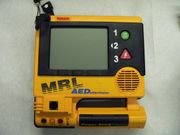Automated external defibrillator
home defibrillator
portable defibrillator
phillips defibrillator
automatic external defibrillator
defibrillator use
internal defibrillator
aed automated external defibrillator
heart defibrillator
automatic defibrillator external help medical refurbished
defibrillator heartstart home
defibrillator manufacturer
mrl defibrillator
defibrillator medical supplier
history of the defibrillator
Automated external defibrillator
Defibrillation was invented and Batelli, two physiologists from University of Geneva, Switzerland. The first use on a human was by Claude Beck, professor of surgery at Western Reserve University that ventricular fibrillation often occurred in hearts which were fundamentally healthy, "Heart too good to die", Automated external defibrillator and that there must be a way of saving them. Beck Automated external defibrillator first used the technique successfully on a 14 year old boy who Automated external defibrillator was being operated on for a congenital chest defect. The boy's Automated external defibrillator chest was surgically opened, and manual cardiac Automated external defibrillator massage was undertaken for 45 minutes until the arrival Automated external defibrillator of the defibrillator. Beck used internal paddles either side of the heart, along with procaine amide, a heart drug, and achieved return of normal sinus rhythm.The technique Automated external defibrillator was often ineffective in reverting VF while morphological Automated external defibrillator studies showed damage to the cells of the heart muscle post mortem. The Automated external defibrillator nature of the AC machine with a large transformer also made these units very hard to transport, and they tended to be large units on wheels.
A circuit diagram Automated external defibrillator showing the simplest (non-electronically controlled) defibrillator Automated external defibrillator design, depending on the inductor ( damping ), producing a Lown, Automated external defibrillator Edmark or Gurvich WaveformIn 1959 Bernard Lown Automated external defibrillator commenced research into an alternative technique which Automated external defibrillator involved charging of a bank of capacitors to 100-200 Joules then Automated external defibrillator delivering the charge through an inductance such as to produce a heavily damped sinusoidal wave of finite duration (~5 msec) to the 'paddle' electrodes. The Lown Automated external defibrillator waveform, as it was known, was the standard for defibrillation Automated external defibrillator until the late 1980's when numerous studies showed that a Automated external defibrillator biphasic truncated waveform (BTE) was equally efficacious Automated external defibrillator while requiring the delivery of lower levels of energy to produce Automated external defibrillator defibrillation.
Defibrillators become portable A major Automated external defibrillator breakthrough was the introduction of portable defibrillators in ambulances. This was pioneered in the early 1960's by Prof. Frank Pantridge in Belfast. Today p Automated external defibrillator ortable defibrillators are one of the most important tools Automated external defibrillator carried by ambulances. They are the only proven way to resuscitate Automated external defibrillator a person who has had a cardiac arrest unwitnessed. Gradual Automated external defibrillator improvements in the design of defibrillators, and partly Automated external defibrillator based on the work developing implanted versions to the availability of Automated External Defibrillators, which can analyse the heart rhythm by themselves, Automated external defibrillator diagnosing the shockable rhythms, and then charging to treat. This means that Automated external defibrillator no clinical skill is required in their use, allowing lay people to respond to emergencies effectively. Until recently, Automated external defibrillator external defibrillators relied on monophasic shock waves. Electrical Automated external defibrillator pulses are sent rapidly from one electrode to the other, Automated external defibrillator only in one direction. Biphasic defibrillation, however, Automated external defibrillator alternates the direction of the pulses, completing one cycle in Automated external defibrillator approximately 10 milliseconds. Biphasic defibrillation was Automated external defibrillator originally developed and used for implantable cardioverter-defibrillators. When Automated external defibrillator applied to external defibrillators, biphasic defibrillation This, in turn, decreases risk of burns and myocardial damage Automated external defibrillator. Ventricular fibrillation (VF) Automated external defibrillator could persist in about 40% of cardiac arrest patients treated with a single shock from a monophasic defibrillator. Most Automated external defibrillator biphasic defibrillators have a first shock success rate Automated external defibrillator (VF is eliminated and a normal rhythm can be returned) of greater than 90%.
Abonohu te:
Posto komente (Atom)

Nuk ka komente:
Posto një koment